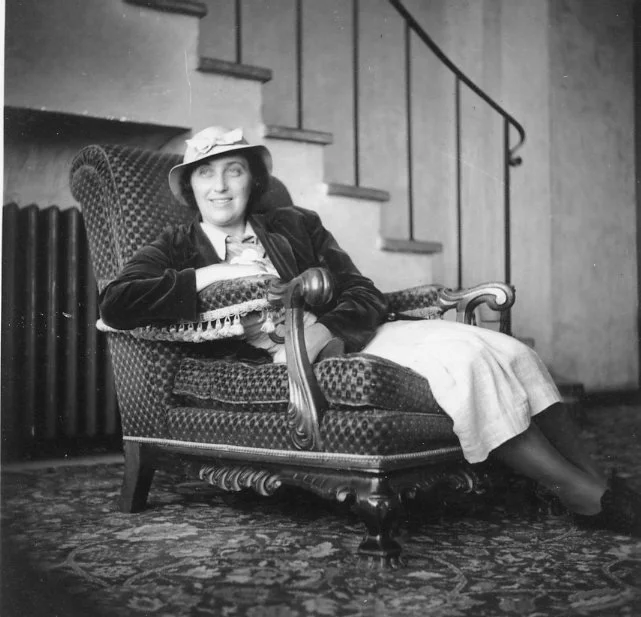The Chair, the Bench, and the Spaces In Between
A Biography in Objects
A turned-wood chair. A velvet scroll-arm. A solitary bench by the lake.
Through furniture, one woman’s life unfolds — not in ownership, but in presence.
At Acanthus Home, we read interiors like biographies, where each restored antique carries the quiet weight of memory and design.
She was born in 1897 in New York City, just a few blocks from Central Park and the Harlem River. The city was newly unified into five boroughs and expanding skyward, yet daily life still unfolded on the stoop. Horse-drawn carriages, street vendors, and coal-fired hearths set the rhythm of her earliest years. Inside, homes were layered with texture and intention — lace curtains, pressed tin ceilings, and furniture that carried both function and memory.
The Language of Interiors
At the turn of the 20th century, the parlor was more than a room; it was a stage for values. Velvet cushions and polished wood expressed refinement, while lace drapery and perfectly placed chairs signaled care and respectability. Upholstery was safeguarded as both an aesthetic choice and a point of pride. Small embroidered cloths called antimacassars draped across the arms and backs of chairs, first to guard against the fashionable hair oils of the day, and later as emblems of gentility — washed, pressed, and laundered as part of weekly domestic ritual.
In this world, beauty was inseparable from care. Furniture wasn’t replaced to follow trends. It was preserved, reupholstered when necessary, and quietly revered. A chair that showed age was not discarded. It was dignified.
1902: A Portrait of Placement
By 1902, she appears in a studio portrait: a girl of five, seated in a turned-wood spindle-back chair. Her boots are laced precisely, her expression composed. A richly patterned rug rests beneath her feet, softened by a pale white fur—lamb or fox—draped with precision. Behind her, a painted backdrop suggests stonework or stained glass, completing a scene designed to elevate and idealize.
From the Acanthus Home private archive, 1902.
She sits lightly, yet with presence. Her hand rests on the top rail, her legs gently folded. She does not pose on the chair but rather within it. A passing object, perhaps—but one that holds something enduring.
These portraits were never meant to document the furniture. And yet, the furniture remains.
1935: A Life, Reframed
She reappears in 1935.
Now grown, she reclines into a carved scroll-armed chair. The setting is quieter. A stairwell rises behind her; a patterned rug softens the floor. Her expression is serene, self-assured. The chair is grander now, upholstered in diamond-patterned cut velvet, its claw feet and scroll arms speaking to the layered elegance of the period’s luxury home interiors.
From the Acanthus Home private archive, 1935.
In 1902, she was placed. By 1935, she chooses. Her hand drapes easily over the scroll arm. Her presence fills the frame. The chair, like the moment, holds her with deference.
What Furniture Remembers
She was never photographed for the furniture. And yet, through these chairs—and through the absence of one—we trace the contours of her life.
The turned-wood chair in New York, 1902. A fleeting moment beside the lake in Westlake Park (now MacArthur Park) in Los Angeles, where she stood in 1915 as Frank photographed her—just before their story truly began. Then, in 1919, it is Frank who sits alone on a bench, writing to her, remembering her. Finally, the scroll-arm chair in 1935, where she is no longer waiting but at ease.
None of these pieces were hers to own. And yet all of them held something: a gesture, a softness, a continuity. They are not merely furnishings. They are biographical objects—the kind found not in catalogs, but in the corners of lived interiors.
The Acanthus Philosophy
At Acanthus Home, we believe furniture is never just a backdrop. Each piece is a biography, told in grain, form, and fabric. Our curated collection of antique furniture, heirloom seating, and vintage home décor is restored with quiet reverence—honoring traditional craftsmanship and natural materials like walnut, oak, and hand-selected velvet.
Every chair we restore is chosen for its ability to speak—not only stylistically, but emotionally. Our clients aren’t searching for a trend. They’re seeking something felt. It might be a collectible antique chair reupholstered for a layered interior in the hills above Los Angeles, or a velvet-clad armchair placed with intention in a historic coastal home. Each piece offers more than beauty. It offers presence.
For interior designers crafting refined spaces and collectors drawn to quiet luxury, these heirlooms invite resonance—something modern design too often forgets.
To Those Who Understand the Weight of a Chair
Not every story is told in words. Some are told in form — in the way a woman rests her hand on a scroll arm, or in the way a man, years later, returns to a bench not for comfort, but to remember.
In the pieces we restore, presence lives on. These are not furnishings to be cycled with the seasons, nor are they dictated by trend. They are heirlooms-in-the-making — objects of continuity, holding memory within grain, form, and fabric.
Our Heirloom Seating Collection is curated for aesthetes, designers, and collectors who understand that beauty is not simply seen; it is felt. To own one is to participate in its story, to become a chapter in its biography.
If this speaks to you, linger.
Explore the collection. Read the journals. And discover what still lives in the spaces between posture and presence.

